Early Childhood Studies: Research Report on Maths Phobia in Children
VerifiedAdded on 2021/04/16
|11
|2934
|61
Report
AI Summary
This report delves into the phenomenon of maths phobia in early childhood, focusing on children aged 3-8. It explores the societal myths surrounding mathematics and their impact on children's attitudes towards the subject. The research employs an interpretivist paradigm and experimental study design, utilizing qualitative data collection through focus groups. The objectives include analyzing the causes of maths phobia, its effects on academic performance, and the contribution of teaching methods in reducing it. The report outlines the research design, including interview settings, participant selection, and data collection methods, while also addressing ethical considerations such as informed consent and data reliability. The study aims to identify effective strategies for coping with maths-related stress in early childhood, emphasizing the importance of proactive teaching and a positive learning environment.
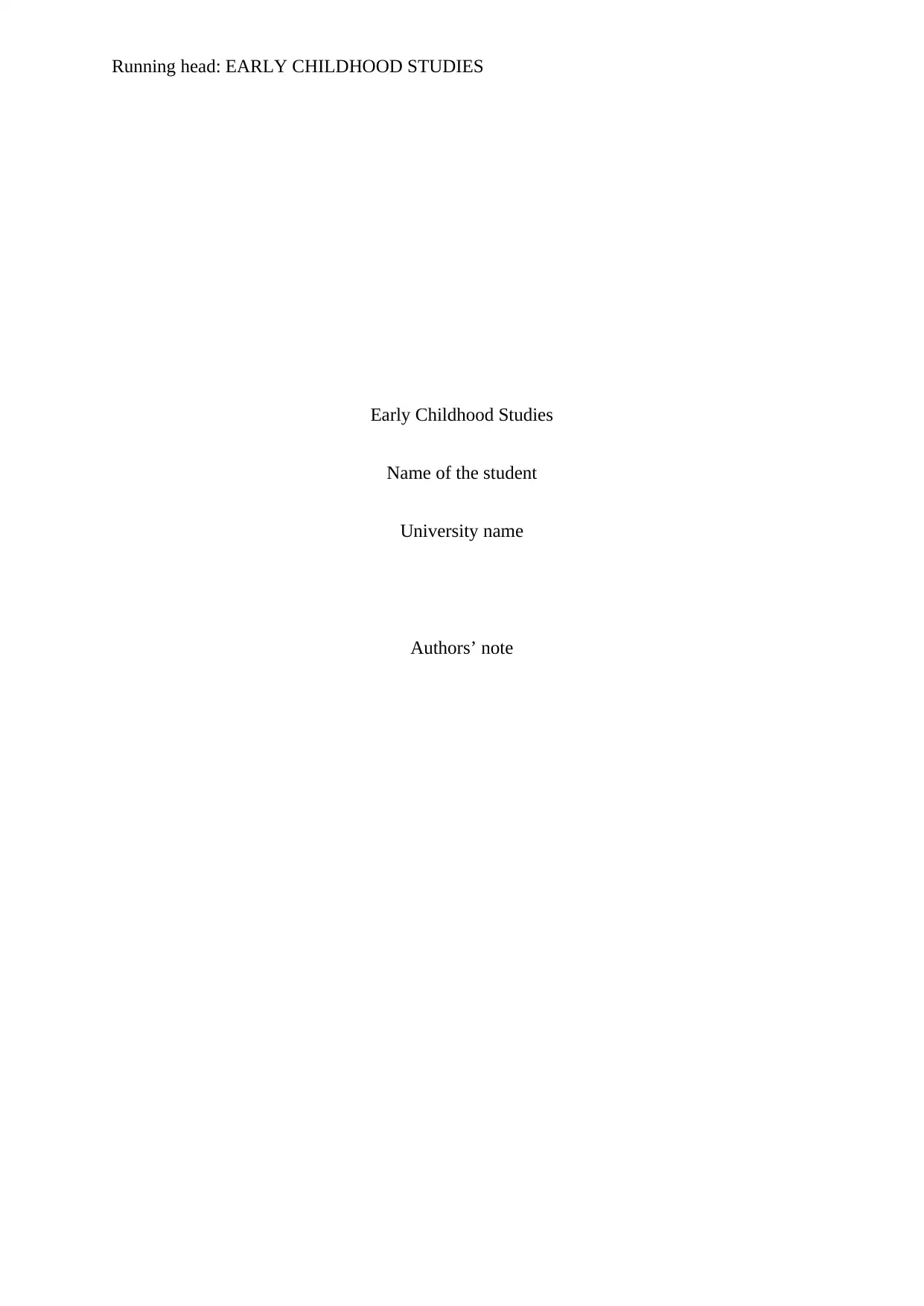
Running head: EARLY CHILDHOOD STUDIES
Early Childhood Studies
Name of the student
University name
Authors’ note
Early Childhood Studies
Name of the student
University name
Authors’ note
Paraphrase This Document
Need a fresh take? Get an instant paraphrase of this document with our AI Paraphraser
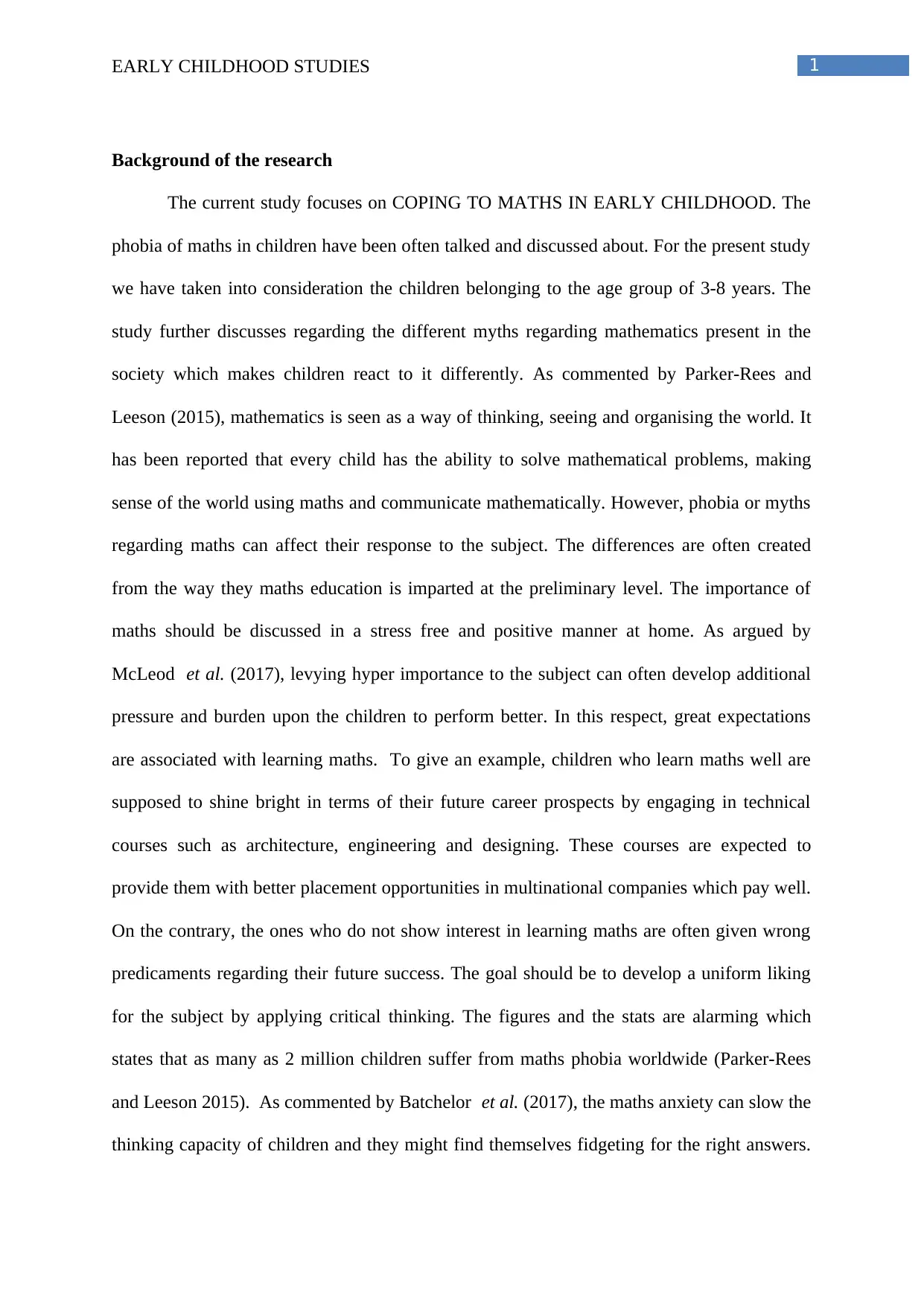
1EARLY CHILDHOOD STUDIES
Background of the research
The current study focuses on COPING TO MATHS IN EARLY CHILDHOOD. The
phobia of maths in children have been often talked and discussed about. For the present study
we have taken into consideration the children belonging to the age group of 3-8 years. The
study further discusses regarding the different myths regarding mathematics present in the
society which makes children react to it differently. As commented by Parker-Rees and
Leeson (2015), mathematics is seen as a way of thinking, seeing and organising the world. It
has been reported that every child has the ability to solve mathematical problems, making
sense of the world using maths and communicate mathematically. However, phobia or myths
regarding maths can affect their response to the subject. The differences are often created
from the way they maths education is imparted at the preliminary level. The importance of
maths should be discussed in a stress free and positive manner at home. As argued by
McLeod et al. (2017), levying hyper importance to the subject can often develop additional
pressure and burden upon the children to perform better. In this respect, great expectations
are associated with learning maths. To give an example, children who learn maths well are
supposed to shine bright in terms of their future career prospects by engaging in technical
courses such as architecture, engineering and designing. These courses are expected to
provide them with better placement opportunities in multinational companies which pay well.
On the contrary, the ones who do not show interest in learning maths are often given wrong
predicaments regarding their future success. The goal should be to develop a uniform liking
for the subject by applying critical thinking. The figures and the stats are alarming which
states that as many as 2 million children suffer from maths phobia worldwide (Parker-Rees
and Leeson 2015). As commented by Batchelor et al. (2017), the maths anxiety can slow the
thinking capacity of children and they might find themselves fidgeting for the right answers.
Background of the research
The current study focuses on COPING TO MATHS IN EARLY CHILDHOOD. The
phobia of maths in children have been often talked and discussed about. For the present study
we have taken into consideration the children belonging to the age group of 3-8 years. The
study further discusses regarding the different myths regarding mathematics present in the
society which makes children react to it differently. As commented by Parker-Rees and
Leeson (2015), mathematics is seen as a way of thinking, seeing and organising the world. It
has been reported that every child has the ability to solve mathematical problems, making
sense of the world using maths and communicate mathematically. However, phobia or myths
regarding maths can affect their response to the subject. The differences are often created
from the way they maths education is imparted at the preliminary level. The importance of
maths should be discussed in a stress free and positive manner at home. As argued by
McLeod et al. (2017), levying hyper importance to the subject can often develop additional
pressure and burden upon the children to perform better. In this respect, great expectations
are associated with learning maths. To give an example, children who learn maths well are
supposed to shine bright in terms of their future career prospects by engaging in technical
courses such as architecture, engineering and designing. These courses are expected to
provide them with better placement opportunities in multinational companies which pay well.
On the contrary, the ones who do not show interest in learning maths are often given wrong
predicaments regarding their future success. The goal should be to develop a uniform liking
for the subject by applying critical thinking. The figures and the stats are alarming which
states that as many as 2 million children suffer from maths phobia worldwide (Parker-Rees
and Leeson 2015). As commented by Batchelor et al. (2017), the maths anxiety can slow the
thinking capacity of children and they might find themselves fidgeting for the right answers.
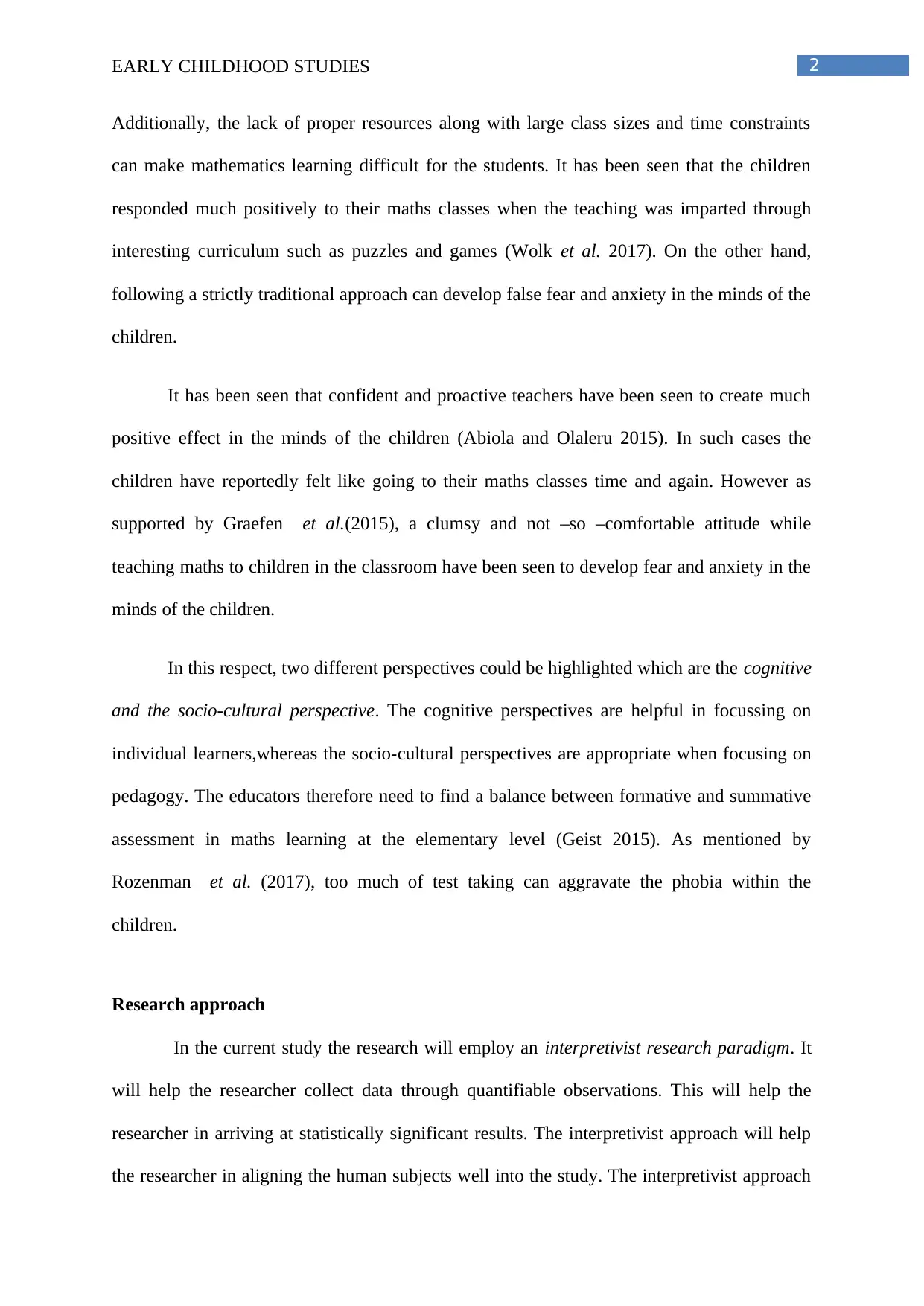
2EARLY CHILDHOOD STUDIES
Additionally, the lack of proper resources along with large class sizes and time constraints
can make mathematics learning difficult for the students. It has been seen that the children
responded much positively to their maths classes when the teaching was imparted through
interesting curriculum such as puzzles and games (Wolk et al. 2017). On the other hand,
following a strictly traditional approach can develop false fear and anxiety in the minds of the
children.
It has been seen that confident and proactive teachers have been seen to create much
positive effect in the minds of the children (Abiola and Olaleru 2015). In such cases the
children have reportedly felt like going to their maths classes time and again. However as
supported by Graefen et al.(2015), a clumsy and not –so –comfortable attitude while
teaching maths to children in the classroom have been seen to develop fear and anxiety in the
minds of the children.
In this respect, two different perspectives could be highlighted which are the cognitive
and the socio-cultural perspective. The cognitive perspectives are helpful in focussing on
individual learners,whereas the socio-cultural perspectives are appropriate when focusing on
pedagogy. The educators therefore need to find a balance between formative and summative
assessment in maths learning at the elementary level (Geist 2015). As mentioned by
Rozenman et al. (2017), too much of test taking can aggravate the phobia within the
children.
Research approach
In the current study the research will employ an interpretivist research paradigm. It
will help the researcher collect data through quantifiable observations. This will help the
researcher in arriving at statistically significant results. The interpretivist approach will help
the researcher in aligning the human subjects well into the study. The interpretivist approach
Additionally, the lack of proper resources along with large class sizes and time constraints
can make mathematics learning difficult for the students. It has been seen that the children
responded much positively to their maths classes when the teaching was imparted through
interesting curriculum such as puzzles and games (Wolk et al. 2017). On the other hand,
following a strictly traditional approach can develop false fear and anxiety in the minds of the
children.
It has been seen that confident and proactive teachers have been seen to create much
positive effect in the minds of the children (Abiola and Olaleru 2015). In such cases the
children have reportedly felt like going to their maths classes time and again. However as
supported by Graefen et al.(2015), a clumsy and not –so –comfortable attitude while
teaching maths to children in the classroom have been seen to develop fear and anxiety in the
minds of the children.
In this respect, two different perspectives could be highlighted which are the cognitive
and the socio-cultural perspective. The cognitive perspectives are helpful in focussing on
individual learners,whereas the socio-cultural perspectives are appropriate when focusing on
pedagogy. The educators therefore need to find a balance between formative and summative
assessment in maths learning at the elementary level (Geist 2015). As mentioned by
Rozenman et al. (2017), too much of test taking can aggravate the phobia within the
children.
Research approach
In the current study the research will employ an interpretivist research paradigm. It
will help the researcher collect data through quantifiable observations. This will help the
researcher in arriving at statistically significant results. The interpretivist approach will help
the researcher in aligning the human subjects well into the study. The interpretivist approach
⊘ This is a preview!⊘
Do you want full access?
Subscribe today to unlock all pages.

Trusted by 1+ million students worldwide
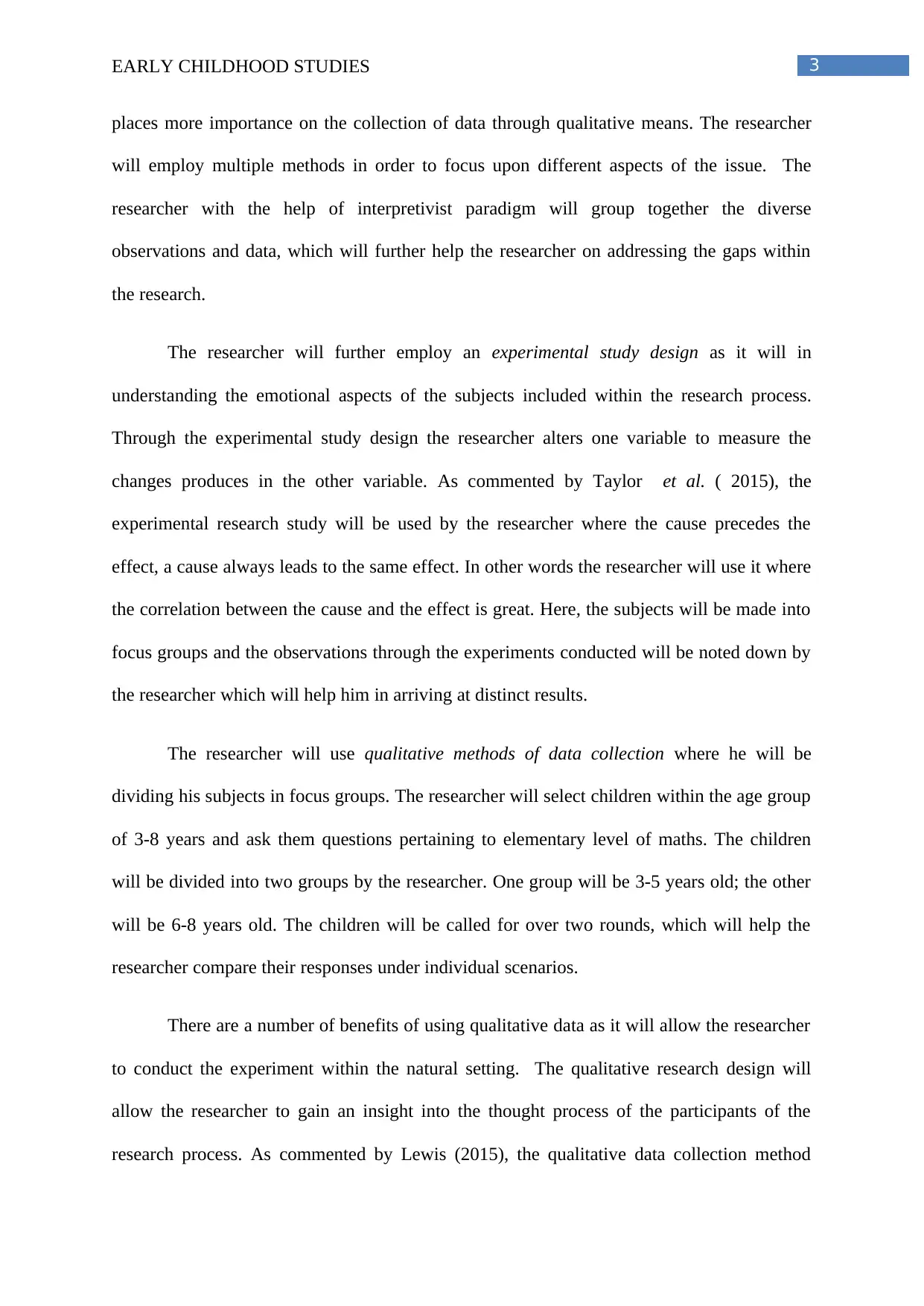
3EARLY CHILDHOOD STUDIES
places more importance on the collection of data through qualitative means. The researcher
will employ multiple methods in order to focus upon different aspects of the issue. The
researcher with the help of interpretivist paradigm will group together the diverse
observations and data, which will further help the researcher on addressing the gaps within
the research.
The researcher will further employ an experimental study design as it will in
understanding the emotional aspects of the subjects included within the research process.
Through the experimental study design the researcher alters one variable to measure the
changes produces in the other variable. As commented by Taylor et al. ( 2015), the
experimental research study will be used by the researcher where the cause precedes the
effect, a cause always leads to the same effect. In other words the researcher will use it where
the correlation between the cause and the effect is great. Here, the subjects will be made into
focus groups and the observations through the experiments conducted will be noted down by
the researcher which will help him in arriving at distinct results.
The researcher will use qualitative methods of data collection where he will be
dividing his subjects in focus groups. The researcher will select children within the age group
of 3-8 years and ask them questions pertaining to elementary level of maths. The children
will be divided into two groups by the researcher. One group will be 3-5 years old; the other
will be 6-8 years old. The children will be called for over two rounds, which will help the
researcher compare their responses under individual scenarios.
There are a number of benefits of using qualitative data as it will allow the researcher
to conduct the experiment within the natural setting. The qualitative research design will
allow the researcher to gain an insight into the thought process of the participants of the
research process. As commented by Lewis (2015), the qualitative data collection method
places more importance on the collection of data through qualitative means. The researcher
will employ multiple methods in order to focus upon different aspects of the issue. The
researcher with the help of interpretivist paradigm will group together the diverse
observations and data, which will further help the researcher on addressing the gaps within
the research.
The researcher will further employ an experimental study design as it will in
understanding the emotional aspects of the subjects included within the research process.
Through the experimental study design the researcher alters one variable to measure the
changes produces in the other variable. As commented by Taylor et al. ( 2015), the
experimental research study will be used by the researcher where the cause precedes the
effect, a cause always leads to the same effect. In other words the researcher will use it where
the correlation between the cause and the effect is great. Here, the subjects will be made into
focus groups and the observations through the experiments conducted will be noted down by
the researcher which will help him in arriving at distinct results.
The researcher will use qualitative methods of data collection where he will be
dividing his subjects in focus groups. The researcher will select children within the age group
of 3-8 years and ask them questions pertaining to elementary level of maths. The children
will be divided into two groups by the researcher. One group will be 3-5 years old; the other
will be 6-8 years old. The children will be called for over two rounds, which will help the
researcher compare their responses under individual scenarios.
There are a number of benefits of using qualitative data as it will allow the researcher
to conduct the experiment within the natural setting. The qualitative research design will
allow the researcher to gain an insight into the thought process of the participants of the
research process. As commented by Lewis (2015), the qualitative data collection method
Paraphrase This Document
Need a fresh take? Get an instant paraphrase of this document with our AI Paraphraser
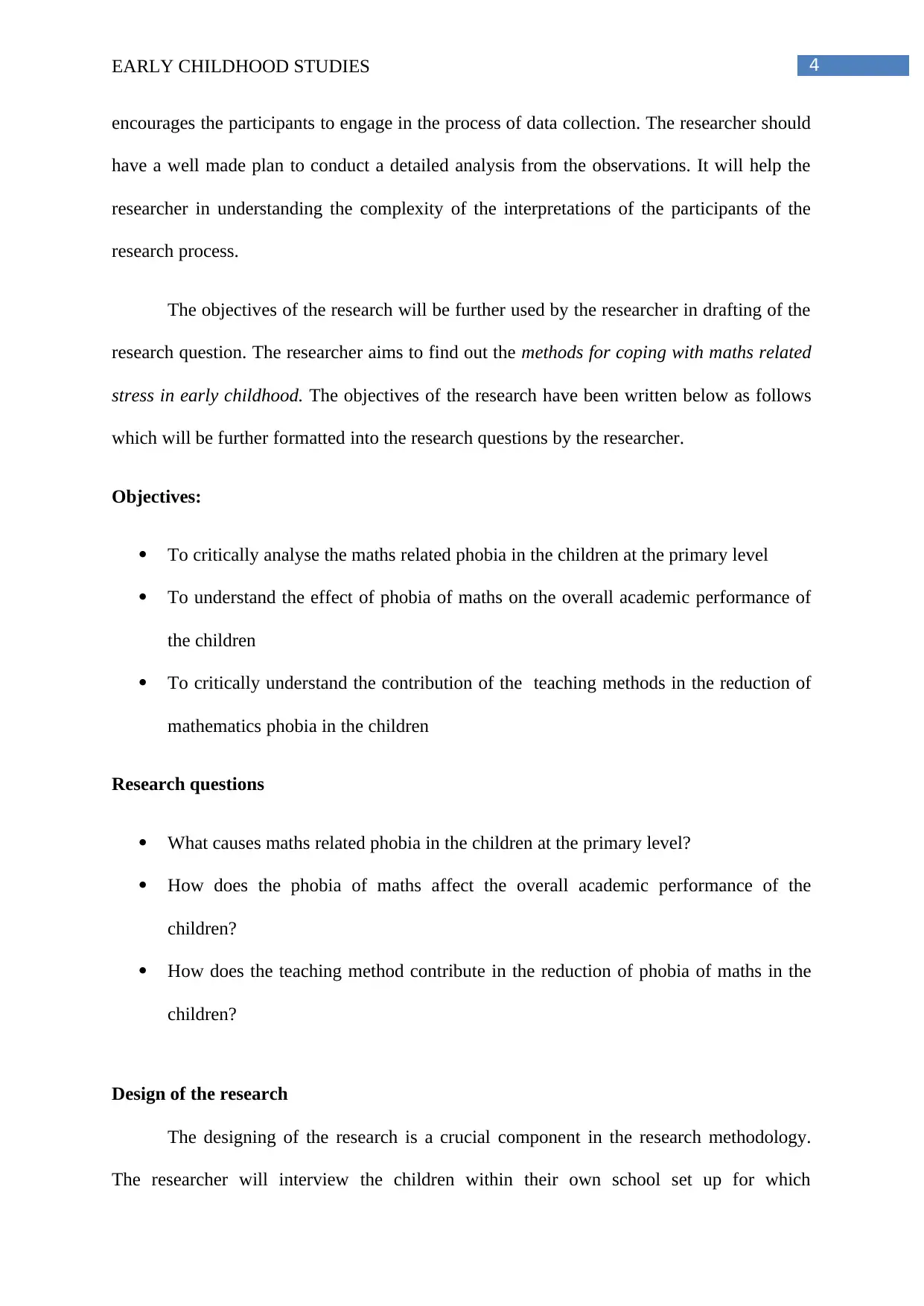
4EARLY CHILDHOOD STUDIES
encourages the participants to engage in the process of data collection. The researcher should
have a well made plan to conduct a detailed analysis from the observations. It will help the
researcher in understanding the complexity of the interpretations of the participants of the
research process.
The objectives of the research will be further used by the researcher in drafting of the
research question. The researcher aims to find out the methods for coping with maths related
stress in early childhood. The objectives of the research have been written below as follows
which will be further formatted into the research questions by the researcher.
Objectives:
To critically analyse the maths related phobia in the children at the primary level
To understand the effect of phobia of maths on the overall academic performance of
the children
To critically understand the contribution of the teaching methods in the reduction of
mathematics phobia in the children
Research questions
What causes maths related phobia in the children at the primary level?
How does the phobia of maths affect the overall academic performance of the
children?
How does the teaching method contribute in the reduction of phobia of maths in the
children?
Design of the research
The designing of the research is a crucial component in the research methodology.
The researcher will interview the children within their own school set up for which
encourages the participants to engage in the process of data collection. The researcher should
have a well made plan to conduct a detailed analysis from the observations. It will help the
researcher in understanding the complexity of the interpretations of the participants of the
research process.
The objectives of the research will be further used by the researcher in drafting of the
research question. The researcher aims to find out the methods for coping with maths related
stress in early childhood. The objectives of the research have been written below as follows
which will be further formatted into the research questions by the researcher.
Objectives:
To critically analyse the maths related phobia in the children at the primary level
To understand the effect of phobia of maths on the overall academic performance of
the children
To critically understand the contribution of the teaching methods in the reduction of
mathematics phobia in the children
Research questions
What causes maths related phobia in the children at the primary level?
How does the phobia of maths affect the overall academic performance of the
children?
How does the teaching method contribute in the reduction of phobia of maths in the
children?
Design of the research
The designing of the research is a crucial component in the research methodology.
The researcher will interview the children within their own school set up for which
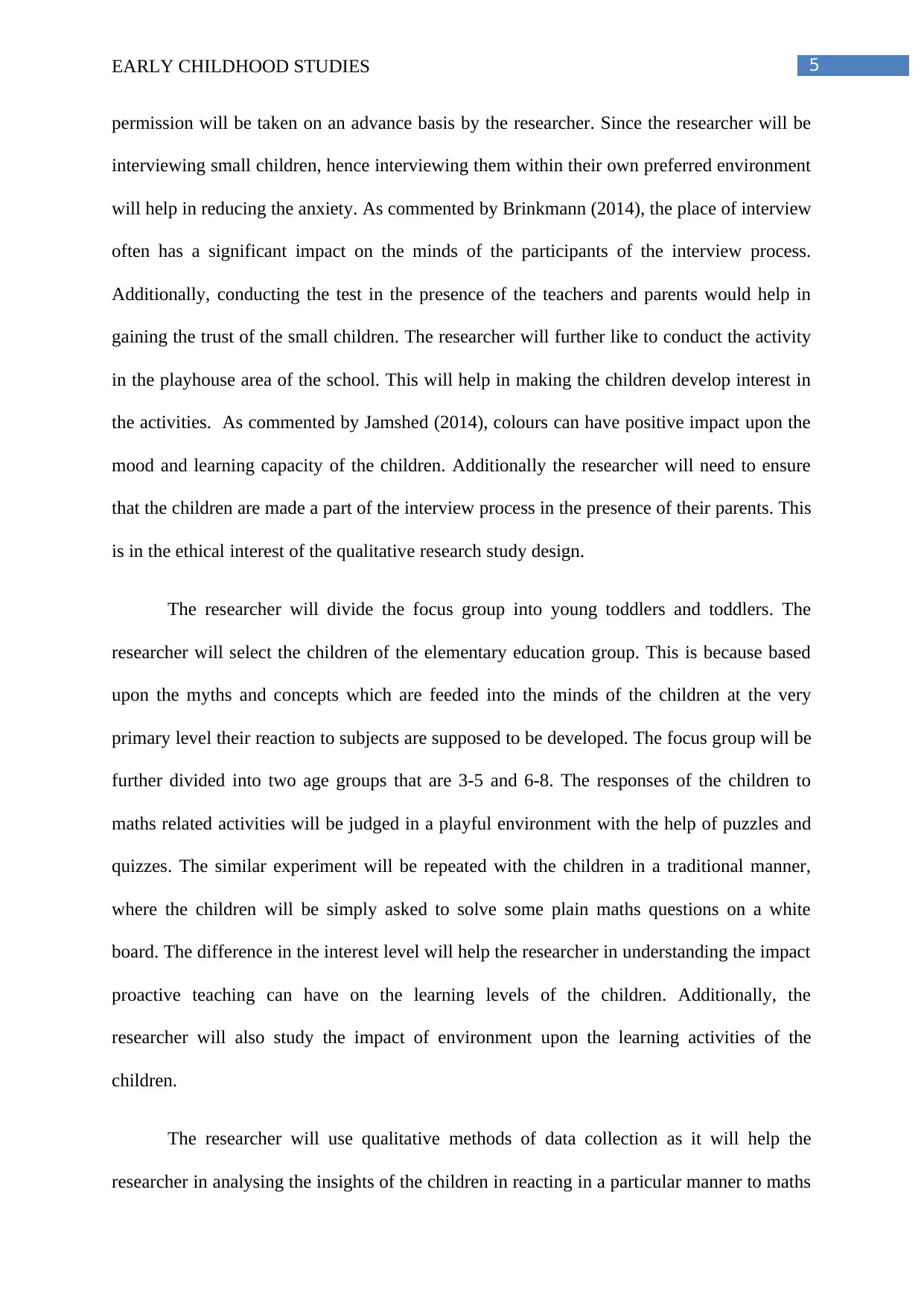
5EARLY CHILDHOOD STUDIES
permission will be taken on an advance basis by the researcher. Since the researcher will be
interviewing small children, hence interviewing them within their own preferred environment
will help in reducing the anxiety. As commented by Brinkmann (2014), the place of interview
often has a significant impact on the minds of the participants of the interview process.
Additionally, conducting the test in the presence of the teachers and parents would help in
gaining the trust of the small children. The researcher will further like to conduct the activity
in the playhouse area of the school. This will help in making the children develop interest in
the activities. As commented by Jamshed (2014), colours can have positive impact upon the
mood and learning capacity of the children. Additionally the researcher will need to ensure
that the children are made a part of the interview process in the presence of their parents. This
is in the ethical interest of the qualitative research study design.
The researcher will divide the focus group into young toddlers and toddlers. The
researcher will select the children of the elementary education group. This is because based
upon the myths and concepts which are feeded into the minds of the children at the very
primary level their reaction to subjects are supposed to be developed. The focus group will be
further divided into two age groups that are 3-5 and 6-8. The responses of the children to
maths related activities will be judged in a playful environment with the help of puzzles and
quizzes. The similar experiment will be repeated with the children in a traditional manner,
where the children will be simply asked to solve some plain maths questions on a white
board. The difference in the interest level will help the researcher in understanding the impact
proactive teaching can have on the learning levels of the children. Additionally, the
researcher will also study the impact of environment upon the learning activities of the
children.
The researcher will use qualitative methods of data collection as it will help the
researcher in analysing the insights of the children in reacting in a particular manner to maths
permission will be taken on an advance basis by the researcher. Since the researcher will be
interviewing small children, hence interviewing them within their own preferred environment
will help in reducing the anxiety. As commented by Brinkmann (2014), the place of interview
often has a significant impact on the minds of the participants of the interview process.
Additionally, conducting the test in the presence of the teachers and parents would help in
gaining the trust of the small children. The researcher will further like to conduct the activity
in the playhouse area of the school. This will help in making the children develop interest in
the activities. As commented by Jamshed (2014), colours can have positive impact upon the
mood and learning capacity of the children. Additionally the researcher will need to ensure
that the children are made a part of the interview process in the presence of their parents. This
is in the ethical interest of the qualitative research study design.
The researcher will divide the focus group into young toddlers and toddlers. The
researcher will select the children of the elementary education group. This is because based
upon the myths and concepts which are feeded into the minds of the children at the very
primary level their reaction to subjects are supposed to be developed. The focus group will be
further divided into two age groups that are 3-5 and 6-8. The responses of the children to
maths related activities will be judged in a playful environment with the help of puzzles and
quizzes. The similar experiment will be repeated with the children in a traditional manner,
where the children will be simply asked to solve some plain maths questions on a white
board. The difference in the interest level will help the researcher in understanding the impact
proactive teaching can have on the learning levels of the children. Additionally, the
researcher will also study the impact of environment upon the learning activities of the
children.
The researcher will use qualitative methods of data collection as it will help the
researcher in analysing the insights of the children in reacting in a particular manner to maths
⊘ This is a preview!⊘
Do you want full access?
Subscribe today to unlock all pages.

Trusted by 1+ million students worldwide
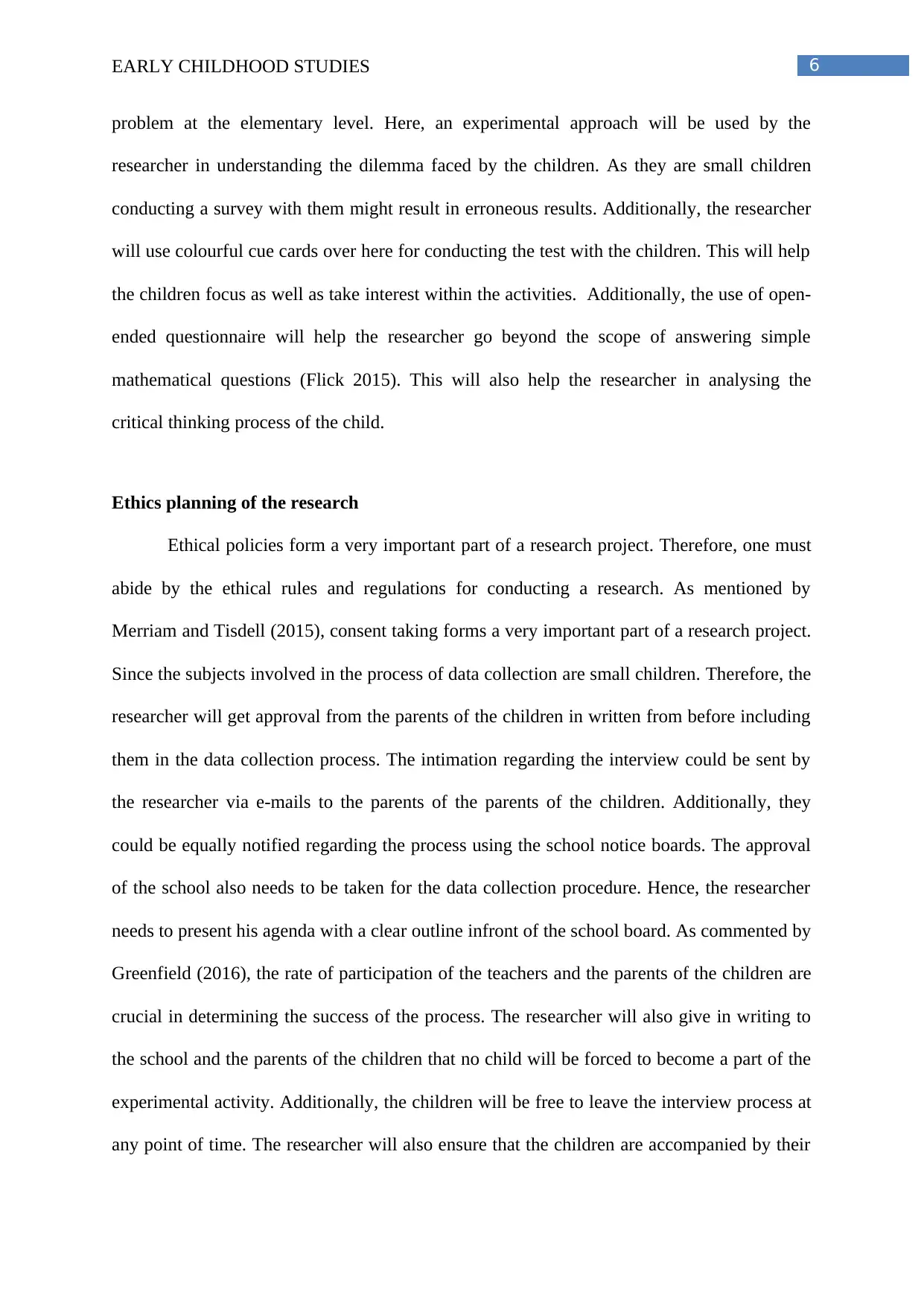
6EARLY CHILDHOOD STUDIES
problem at the elementary level. Here, an experimental approach will be used by the
researcher in understanding the dilemma faced by the children. As they are small children
conducting a survey with them might result in erroneous results. Additionally, the researcher
will use colourful cue cards over here for conducting the test with the children. This will help
the children focus as well as take interest within the activities. Additionally, the use of open-
ended questionnaire will help the researcher go beyond the scope of answering simple
mathematical questions (Flick 2015). This will also help the researcher in analysing the
critical thinking process of the child.
Ethics planning of the research
Ethical policies form a very important part of a research project. Therefore, one must
abide by the ethical rules and regulations for conducting a research. As mentioned by
Merriam and Tisdell (2015), consent taking forms a very important part of a research project.
Since the subjects involved in the process of data collection are small children. Therefore, the
researcher will get approval from the parents of the children in written from before including
them in the data collection process. The intimation regarding the interview could be sent by
the researcher via e-mails to the parents of the parents of the children. Additionally, they
could be equally notified regarding the process using the school notice boards. The approval
of the school also needs to be taken for the data collection procedure. Hence, the researcher
needs to present his agenda with a clear outline infront of the school board. As commented by
Greenfield (2016), the rate of participation of the teachers and the parents of the children are
crucial in determining the success of the process. The researcher will also give in writing to
the school and the parents of the children that no child will be forced to become a part of the
experimental activity. Additionally, the children will be free to leave the interview process at
any point of time. The researcher will also ensure that the children are accompanied by their
problem at the elementary level. Here, an experimental approach will be used by the
researcher in understanding the dilemma faced by the children. As they are small children
conducting a survey with them might result in erroneous results. Additionally, the researcher
will use colourful cue cards over here for conducting the test with the children. This will help
the children focus as well as take interest within the activities. Additionally, the use of open-
ended questionnaire will help the researcher go beyond the scope of answering simple
mathematical questions (Flick 2015). This will also help the researcher in analysing the
critical thinking process of the child.
Ethics planning of the research
Ethical policies form a very important part of a research project. Therefore, one must
abide by the ethical rules and regulations for conducting a research. As mentioned by
Merriam and Tisdell (2015), consent taking forms a very important part of a research project.
Since the subjects involved in the process of data collection are small children. Therefore, the
researcher will get approval from the parents of the children in written from before including
them in the data collection process. The intimation regarding the interview could be sent by
the researcher via e-mails to the parents of the parents of the children. Additionally, they
could be equally notified regarding the process using the school notice boards. The approval
of the school also needs to be taken for the data collection procedure. Hence, the researcher
needs to present his agenda with a clear outline infront of the school board. As commented by
Greenfield (2016), the rate of participation of the teachers and the parents of the children are
crucial in determining the success of the process. The researcher will also give in writing to
the school and the parents of the children that no child will be forced to become a part of the
experimental activity. Additionally, the children will be free to leave the interview process at
any point of time. The researcher will also ensure that the children are accompanied by their
Paraphrase This Document
Need a fresh take? Get an instant paraphrase of this document with our AI Paraphraser
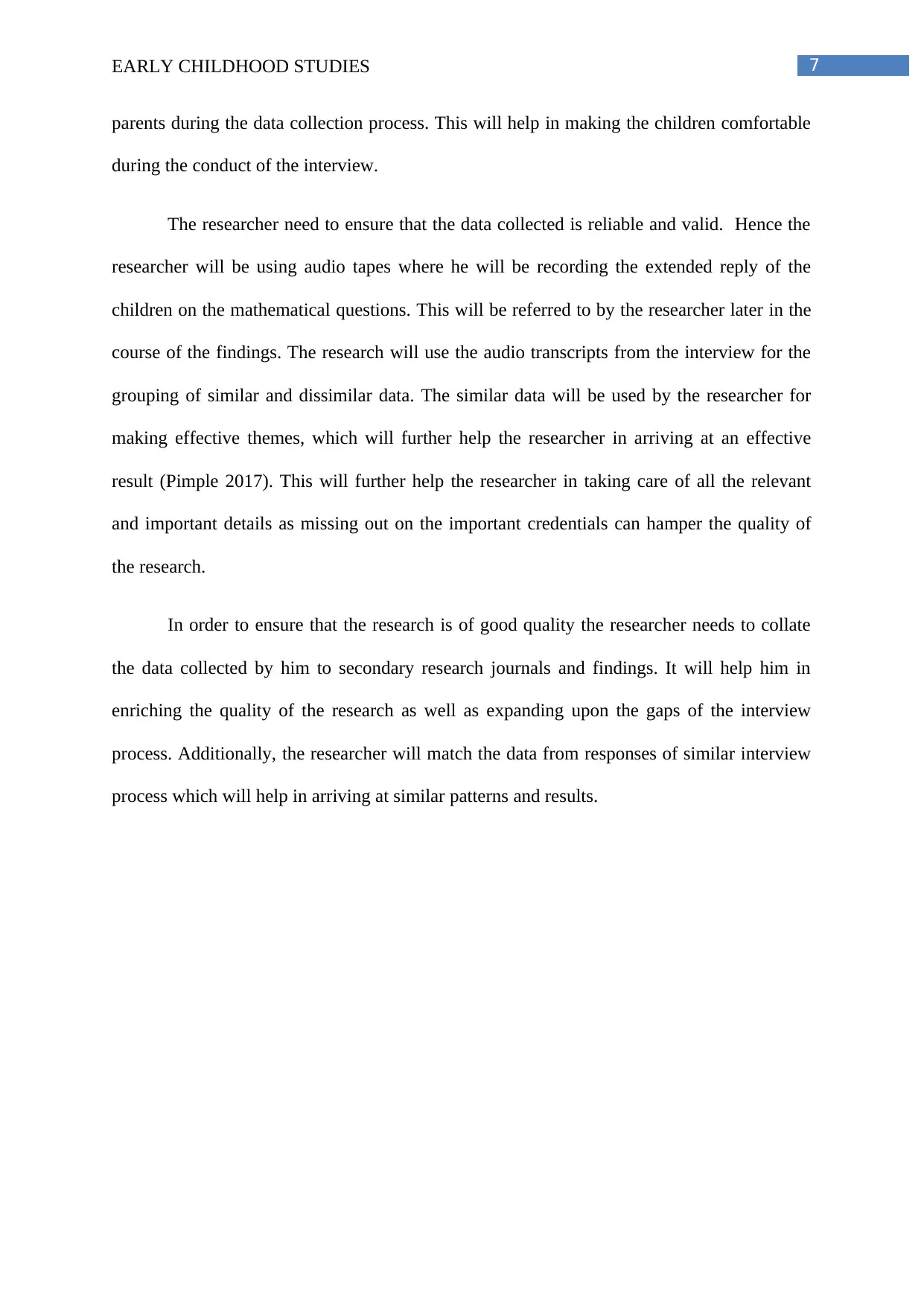
7EARLY CHILDHOOD STUDIES
parents during the data collection process. This will help in making the children comfortable
during the conduct of the interview.
The researcher need to ensure that the data collected is reliable and valid. Hence the
researcher will be using audio tapes where he will be recording the extended reply of the
children on the mathematical questions. This will be referred to by the researcher later in the
course of the findings. The research will use the audio transcripts from the interview for the
grouping of similar and dissimilar data. The similar data will be used by the researcher for
making effective themes, which will further help the researcher in arriving at an effective
result (Pimple 2017). This will further help the researcher in taking care of all the relevant
and important details as missing out on the important credentials can hamper the quality of
the research.
In order to ensure that the research is of good quality the researcher needs to collate
the data collected by him to secondary research journals and findings. It will help him in
enriching the quality of the research as well as expanding upon the gaps of the interview
process. Additionally, the researcher will match the data from responses of similar interview
process which will help in arriving at similar patterns and results.
parents during the data collection process. This will help in making the children comfortable
during the conduct of the interview.
The researcher need to ensure that the data collected is reliable and valid. Hence the
researcher will be using audio tapes where he will be recording the extended reply of the
children on the mathematical questions. This will be referred to by the researcher later in the
course of the findings. The research will use the audio transcripts from the interview for the
grouping of similar and dissimilar data. The similar data will be used by the researcher for
making effective themes, which will further help the researcher in arriving at an effective
result (Pimple 2017). This will further help the researcher in taking care of all the relevant
and important details as missing out on the important credentials can hamper the quality of
the research.
In order to ensure that the research is of good quality the researcher needs to collate
the data collected by him to secondary research journals and findings. It will help him in
enriching the quality of the research as well as expanding upon the gaps of the interview
process. Additionally, the researcher will match the data from responses of similar interview
process which will help in arriving at similar patterns and results.
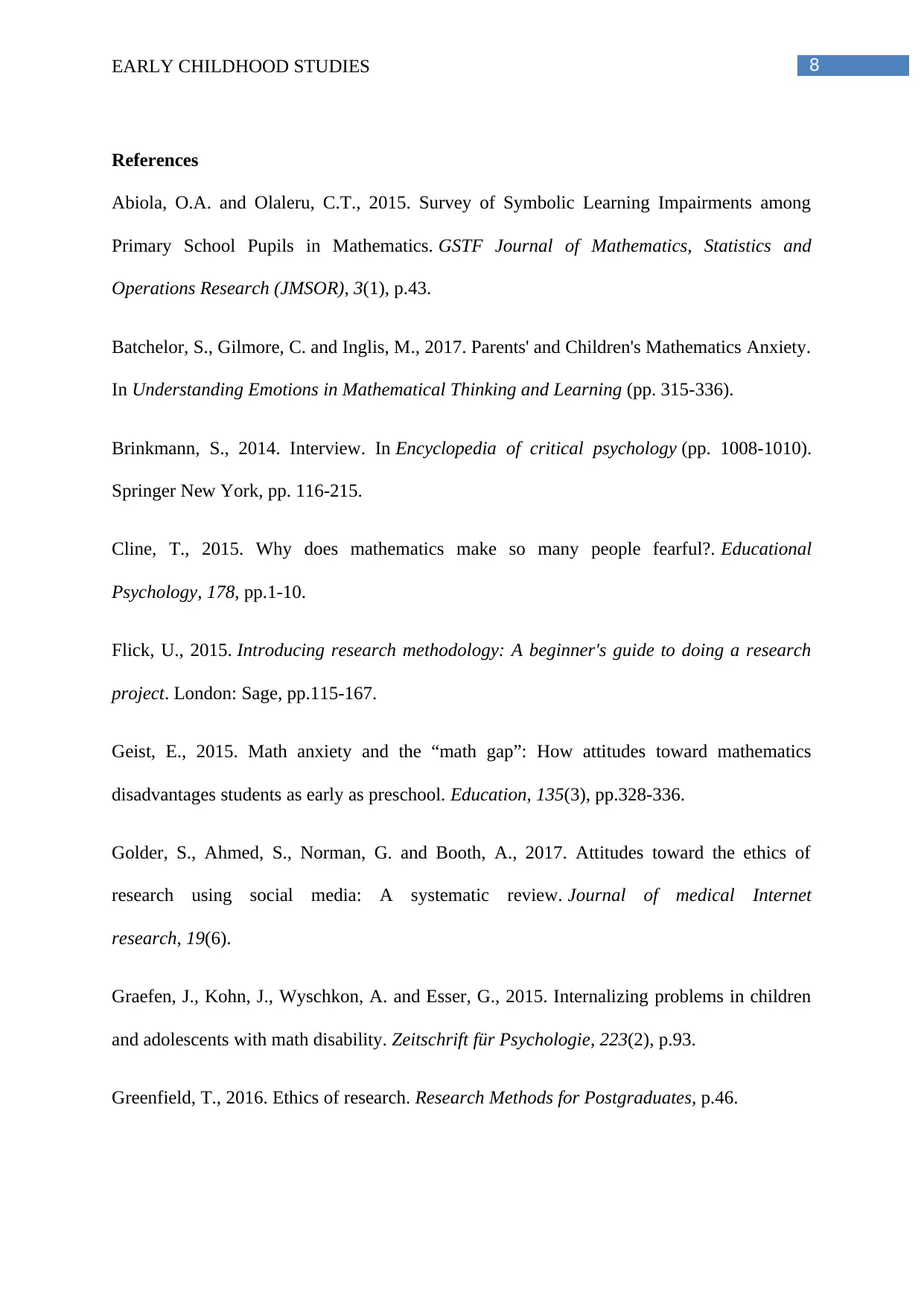
8EARLY CHILDHOOD STUDIES
References
Abiola, O.A. and Olaleru, C.T., 2015. Survey of Symbolic Learning Impairments among
Primary School Pupils in Mathematics. GSTF Journal of Mathematics, Statistics and
Operations Research (JMSOR), 3(1), p.43.
Batchelor, S., Gilmore, C. and Inglis, M., 2017. Parents' and Children's Mathematics Anxiety.
In Understanding Emotions in Mathematical Thinking and Learning (pp. 315-336).
Brinkmann, S., 2014. Interview. In Encyclopedia of critical psychology (pp. 1008-1010).
Springer New York, pp. 116-215.
Cline, T., 2015. Why does mathematics make so many people fearful?. Educational
Psychology, 178, pp.1-10.
Flick, U., 2015. Introducing research methodology: A beginner's guide to doing a research
project. London: Sage, pp.115-167.
Geist, E., 2015. Math anxiety and the “math gap”: How attitudes toward mathematics
disadvantages students as early as preschool. Education, 135(3), pp.328-336.
Golder, S., Ahmed, S., Norman, G. and Booth, A., 2017. Attitudes toward the ethics of
research using social media: A systematic review. Journal of medical Internet
research, 19(6).
Graefen, J., Kohn, J., Wyschkon, A. and Esser, G., 2015. Internalizing problems in children
and adolescents with math disability. Zeitschrift für Psychologie, 223(2), p.93.
Greenfield, T., 2016. Ethics of research. Research Methods for Postgraduates, p.46.
References
Abiola, O.A. and Olaleru, C.T., 2015. Survey of Symbolic Learning Impairments among
Primary School Pupils in Mathematics. GSTF Journal of Mathematics, Statistics and
Operations Research (JMSOR), 3(1), p.43.
Batchelor, S., Gilmore, C. and Inglis, M., 2017. Parents' and Children's Mathematics Anxiety.
In Understanding Emotions in Mathematical Thinking and Learning (pp. 315-336).
Brinkmann, S., 2014. Interview. In Encyclopedia of critical psychology (pp. 1008-1010).
Springer New York, pp. 116-215.
Cline, T., 2015. Why does mathematics make so many people fearful?. Educational
Psychology, 178, pp.1-10.
Flick, U., 2015. Introducing research methodology: A beginner's guide to doing a research
project. London: Sage, pp.115-167.
Geist, E., 2015. Math anxiety and the “math gap”: How attitudes toward mathematics
disadvantages students as early as preschool. Education, 135(3), pp.328-336.
Golder, S., Ahmed, S., Norman, G. and Booth, A., 2017. Attitudes toward the ethics of
research using social media: A systematic review. Journal of medical Internet
research, 19(6).
Graefen, J., Kohn, J., Wyschkon, A. and Esser, G., 2015. Internalizing problems in children
and adolescents with math disability. Zeitschrift für Psychologie, 223(2), p.93.
Greenfield, T., 2016. Ethics of research. Research Methods for Postgraduates, p.46.
⊘ This is a preview!⊘
Do you want full access?
Subscribe today to unlock all pages.

Trusted by 1+ million students worldwide
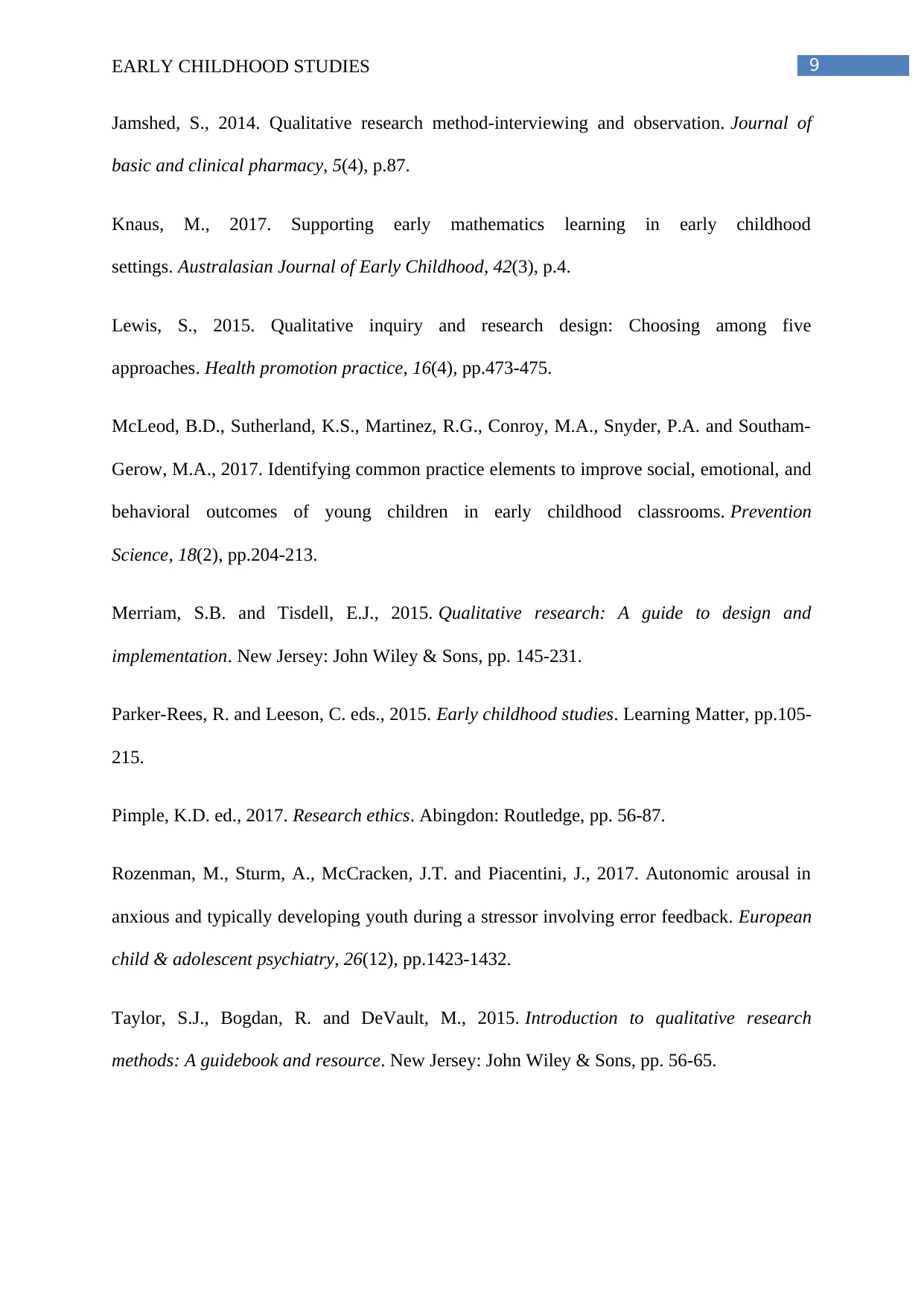
9EARLY CHILDHOOD STUDIES
Jamshed, S., 2014. Qualitative research method-interviewing and observation. Journal of
basic and clinical pharmacy, 5(4), p.87.
Knaus, M., 2017. Supporting early mathematics learning in early childhood
settings. Australasian Journal of Early Childhood, 42(3), p.4.
Lewis, S., 2015. Qualitative inquiry and research design: Choosing among five
approaches. Health promotion practice, 16(4), pp.473-475.
McLeod, B.D., Sutherland, K.S., Martinez, R.G., Conroy, M.A., Snyder, P.A. and Southam-
Gerow, M.A., 2017. Identifying common practice elements to improve social, emotional, and
behavioral outcomes of young children in early childhood classrooms. Prevention
Science, 18(2), pp.204-213.
Merriam, S.B. and Tisdell, E.J., 2015. Qualitative research: A guide to design and
implementation. New Jersey: John Wiley & Sons, pp. 145-231.
Parker-Rees, R. and Leeson, C. eds., 2015. Early childhood studies. Learning Matter, pp.105-
215.
Pimple, K.D. ed., 2017. Research ethics. Abingdon: Routledge, pp. 56-87.
Rozenman, M., Sturm, A., McCracken, J.T. and Piacentini, J., 2017. Autonomic arousal in
anxious and typically developing youth during a stressor involving error feedback. European
child & adolescent psychiatry, 26(12), pp.1423-1432.
Taylor, S.J., Bogdan, R. and DeVault, M., 2015. Introduction to qualitative research
methods: A guidebook and resource. New Jersey: John Wiley & Sons, pp. 56-65.
Jamshed, S., 2014. Qualitative research method-interviewing and observation. Journal of
basic and clinical pharmacy, 5(4), p.87.
Knaus, M., 2017. Supporting early mathematics learning in early childhood
settings. Australasian Journal of Early Childhood, 42(3), p.4.
Lewis, S., 2015. Qualitative inquiry and research design: Choosing among five
approaches. Health promotion practice, 16(4), pp.473-475.
McLeod, B.D., Sutherland, K.S., Martinez, R.G., Conroy, M.A., Snyder, P.A. and Southam-
Gerow, M.A., 2017. Identifying common practice elements to improve social, emotional, and
behavioral outcomes of young children in early childhood classrooms. Prevention
Science, 18(2), pp.204-213.
Merriam, S.B. and Tisdell, E.J., 2015. Qualitative research: A guide to design and
implementation. New Jersey: John Wiley & Sons, pp. 145-231.
Parker-Rees, R. and Leeson, C. eds., 2015. Early childhood studies. Learning Matter, pp.105-
215.
Pimple, K.D. ed., 2017. Research ethics. Abingdon: Routledge, pp. 56-87.
Rozenman, M., Sturm, A., McCracken, J.T. and Piacentini, J., 2017. Autonomic arousal in
anxious and typically developing youth during a stressor involving error feedback. European
child & adolescent psychiatry, 26(12), pp.1423-1432.
Taylor, S.J., Bogdan, R. and DeVault, M., 2015. Introduction to qualitative research
methods: A guidebook and resource. New Jersey: John Wiley & Sons, pp. 56-65.
Paraphrase This Document
Need a fresh take? Get an instant paraphrase of this document with our AI Paraphraser

10EARLY CHILDHOOD STUDIES
Wolk, C.B., Carper, M.M., Kendall, P.C., Olino, T.M., Marcus, S.C. and Beidas, R.S., 2016.
Pathways to anxiety–depression comorbidity: A longitudinal examination of childhood
anxiety disorders. Depression and anxiety, 33(10), pp.978-986.
Wolk, C.B., Carper, M.M., Kendall, P.C., Olino, T.M., Marcus, S.C. and Beidas, R.S., 2016.
Pathways to anxiety–depression comorbidity: A longitudinal examination of childhood
anxiety disorders. Depression and anxiety, 33(10), pp.978-986.
1 out of 11
Related Documents
Your All-in-One AI-Powered Toolkit for Academic Success.
+13062052269
info@desklib.com
Available 24*7 on WhatsApp / Email
![[object Object]](/_next/static/media/star-bottom.7253800d.svg)
Unlock your academic potential
Copyright © 2020–2025 A2Z Services. All Rights Reserved. Developed and managed by ZUCOL.





